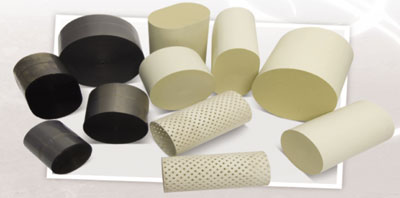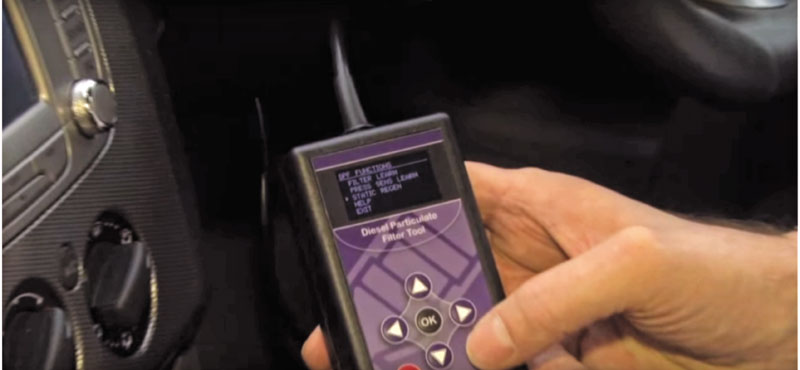Stuart Still, Technical Trainer, EEC looks at an issue where the warning light was illuminated and the car was in ‘limp’ mode.
I was recently contacted by one of our distributors and asked if I would try and appease one of his customers. He was insisting that the DPF he had fitted to a Vauxhall Zafira a few months previous was faulty because the DPF light was on, it was smoking heavily and kept going into ‘limp’ mode. I phoned the customer to get some more information as to why and how the DPF was replaced.
The customer explained that the DPF was replaced due to the damage caused when the inlet manifold swirl flaps collapsed. These were subsequently replaced, the EGR valve was cleaned, the ECU was reset and a ‘forced’ regeneration was completed. A week later it went into limp mode again and started smoking, at which point the garage diagnosed that the DPF was faulty!!
To help with the interrogation, I arranged a site visit to the garage along with our distributor so that I could evaluate the situation at first hand.
On my arrival the mechanic explained that the problem was ‘definitely’ the DPF as the diagnostic tool had reported ‘DPF full’, and the exhaust was constantly emitting smoke. I started the engine and brought the temperature up to 70˚C, before connecting my EEC DPF reset tool which reported a ‘Turbo Boost’ problem. The mechanic’s diagnosis was that this was due to the blocked DPF!
 During the time that the engine was running there was a constant flow of blue smoke coming from the exhaust tail pipe, which the technician also insisted was due to the blocked DPF. I explained that the blue smoke was burning oil, likely due to an engine problem. In this instance the oil can enter the combustion chamber from several sources, including:
During the time that the engine was running there was a constant flow of blue smoke coming from the exhaust tail pipe, which the technician also insisted was due to the blocked DPF. I explained that the blue smoke was burning oil, likely due to an engine problem. In this instance the oil can enter the combustion chamber from several sources, including:
■ Worn valve guides or seals.
■ Cylinder and/or piston ring wear.
■ Cylinder glaze.
■ Piston ring sticking.
■ Incorrect grade of oil being too thin and getting past rings, or valve guides.
■ Fuel dilution of the oil, making it too thin, which can be the result of the DPF regeneration process.
■ If the fault is not found and rectified immediately the DPF’s monolith will become coated with oil, making it inoperable.
At this stage I pointed to a large, black oily deposit on the ground directly beneath the exhaust tail pipe; this helped the mechanic to come to the same conclusion that the problem was not the DPF.
How do DPFs work?
The DPFs that are currently fitted to the majority of diesel vehicles are basically just a filter for the collection and disposal of sooty particles or (PM) Particulate Matter that are produced during combustion of the diesel fuel/air mixture. Incomplete combustion due to engine faults or a lack of servicing will also increase the amount of PM produced. This will almost certainly result in premature DPF blockage.
The DPF is a serviceable item which will need replacing at some time. These intervals can vary with Ford advising replacement at 75k miles and BMW recommending 150k instead.
The composition of the particles varies widely dependent upon engine type, age, and the emissions specification that the engine was designed to meet. Wall-flow diesel particulate filters usually remove 85% or more of the soot and can at times (in heavily loaded conditions) attain soot removal efficiencies close to 100%.
A DPF filter core looks similar to a catalytic converter core that has had alternate channels plugged. These plugs force the exhaust gas flow through the wall, and the particulate collects on the inlet face. This is unlike a catalytic converter which is a flow-through device. Exhaust gases are cleaned with a DPF by forcing the gas to flow through the filter.

In addition to collecting the particulate, a method must exist to clean the filter. Through engine modifications the engine is set to run a specific way; when the filter load reaches a pre-determined level (about 40% full) the ECU activates the regeneration process which will inject up to eight times the amount of fuel per stroke. This will increase the temperature within the DPF to over 550 degrees and is more commonly known as “filter regeneration”.
PSA vehicles as well as some Minis and Volvo models use a slightly different system; they have an additional tank (usually located in the boot) which injects a chemical called ‘Eolys’ into the diesel. This reduces the burning temperature of the PM within the DPF to 450˚. It should also be noted that, when topping up the fluid, you must reset the ECU at the same time.
EEC’s offering
European Exhaust & Catalysts (EEC) has an extensive range of DPFs which is increasing day-by-day and the company is committed to an education and training programme within the industry to help technicians understand, evaluate and diagnose emission problems.

DPF problems – essential advice
1. If the DPF light is illuminated, the DPF will need to be regenerated. If you check the manufacturer’s handbook it explains that you will need to drive the vehicle for about 20 to 25 minutes at over 2,500 RPM.
2. If the engine management light comes on and the glow plug light flashes then you will not be able to regenerate the DPF by driving.
3. ‘Limp home’ mode will engage, with a maximum of 3,000 RPM.
4. Check the pressure sensors as there could be a build-up of water.
5. Examine pressure pipes for damage. These must be clean or they could freeze in extreme temperatures due to condensation build up.
6. Check that the EGR system is clean and working correctly.
7. Check that the vehicle has the correct specification engine oil.
8. Check the fuel additive Eolys/Cerine.
9. If the DPF does not regenerate due to engine related faults or driving practises (short stop/start journeys) and fills to over 90% or 45 grams, the DPF will need replacing. This is not covered under warranty.
10. When a new DPF is fitted the ECU must be readapted/reset, followed by a forced regeneration. This is to ensure that the ECU knows that the DPF and all related sensors are reset.
11. It is possible to carry out a forced DPF regeneration by using the correct diagnostic machine. Depending on the vehicle, this operation could be static or dynamic and will likely take up to 40 minutes.
The DPF WILL NOT regenerate if:
- a) The engine management light is on as a result of a particular fault.
- b) The EGR valve is faulty.
- c) There is less than 20 litres of fuel in the fuel tank or if the fuel light is on.










